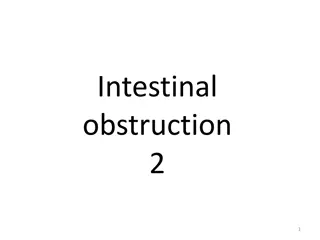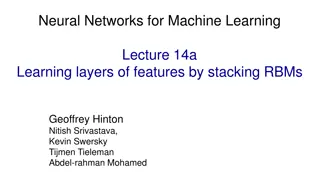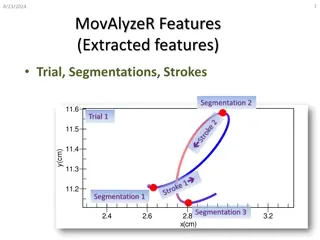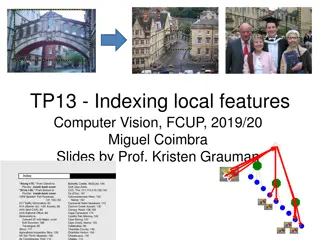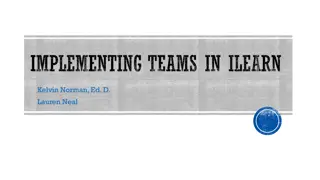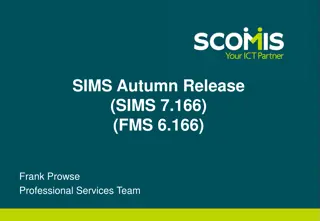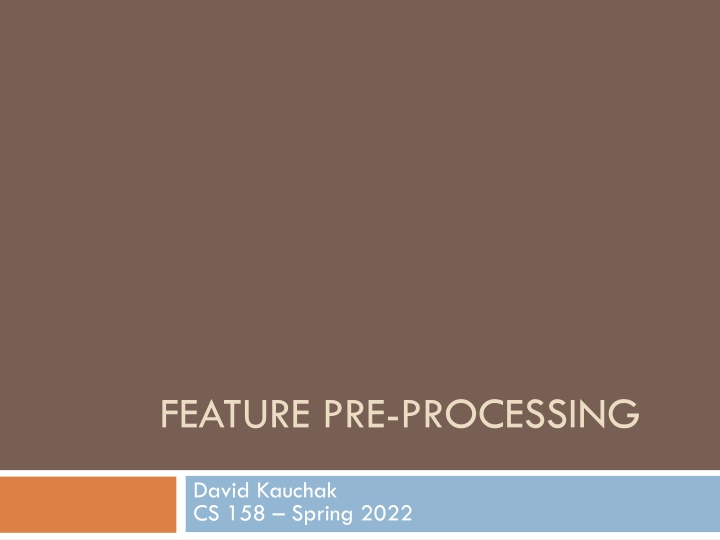
Predictive Analytics and Feature Pre-Processing in Machine Learning
Explore various datasets and predictive modeling scenarios including feature pre-processing, decision tree experiments, and predictive features for abalone age and breast cancer recurrence. Learn about datasets from UCI Machine Learning Repository and understand the importance of data pre-processing in building accurate models.
Download Presentation

Please find below an Image/Link to download the presentation.
The content on the website is provided AS IS for your information and personal use only. It may not be sold, licensed, or shared on other websites without obtaining consent from the author. If you encounter any issues during the download, it is possible that the publisher has removed the file from their server.
You are allowed to download the files provided on this website for personal or commercial use, subject to the condition that they are used lawfully. All files are the property of their respective owners.
The content on the website is provided AS IS for your information and personal use only. It may not be sold, licensed, or shared on other websites without obtaining consent from the author.
E N D
Presentation Transcript
FEATURE PRE-PROCESSING David Kauchak CS 158 Spring 2022
Admin Assignment 1 graded Sakai submission?? Assignment 2 This class will make you a better programmer! How did it go? How much time did you spend? Assignment 3 out Implement perceptron variants See how they differ in performance
Assignment 2 experiments How good was the decision tree? How deep did it need to be? Overfitting? Training data size?
Features Terrain Unicycle- type Weather Go-For-Ride? Trail Normal Rainy NO Road Normal Sunny YES Trail Mountain Sunny YES Road Mountain Rainy YES Trail Normal Snowy NO Road Normal Rainy YES Road Mountain Snowy YES Trail Normal Sunny NO Road Normal Snowy NO Trail Mountain Snowy YES Where do they come from?
UCI Machine Learning Repository http://archive.ics.uci.edu/ml/datasets.html
Provided features Predicting the age of abalone from physical measurements Name / Data Type / Measurement Unit / Description ----------------------------- Sex / nominal / -- / M, F, and I (infant) Length / continuous / mm / Longest shell measurement Diameter / continuous / mm / perpendicular to length Height / continuous / mm / with meat in shell Whole weight / continuous / grams / whole abalone Shucked weight / continuous / grams / weight of meat Viscera weight / continuous / grams / gut weight (after bleeding) Shell weight / continuous / grams / after being dried Rings / integer / -- / +1.5 gives the age in years
Provided features Predicting breast cancer recurrence 1. Class: no-recurrence-events, recurrence-events 2. age: 10-19, 20-29, 30-39, 40-49, 50-59, 60-69, 70-79, 80-89, 90-99. 3. menopause: lt40, ge40, premeno. 4. tumor-size: 0-4, 5-9, 10-14, 15-19, 20-24, 25-29, 30-34, 35-39, 40-44, 45-49, 50-54, 55-59. 5. inv-nodes: 0-2, 3-5, 6-8, 9-11, 12-14, 15-17, 18-20, 21-23, 24-26, 27-29, 30-32, 33- 35, 36-39. 6. node-caps: yes, no. 7. deg-malig: 1, 2, 3. 8. breast: left, right. 9. breast-quad: left-up, left-low, right-up, right-low, central. 10. irradiated: yes, no.
Provided features In many physical domains (e.g. biology, medicine, chemistry, engineering, etc.) the data has been collected and the relevant features have been identified we cannot collect more features from the examples (at least core features) In these domains, we can often just use the provided features
Raw data vs. features In other domains, we are provided with the raw data, but must extract/identify features For example image data text data audio data log data
How is an image represented? images are made up of pixels for a color image, each pixel corresponds to an RGB value (i.e. three numbers)
Image features for each pixel: R[0-255] G[0-255] B[0-255] Do we retain all the information in the original document?
Image features for each pixel: R[0-255] G[0-255] B[0-255] Other features for images?
Lots of image features Use patches rather than pixels (sort of like bigrams for text) Different color representations (i.e. L*A*B*) Texture features, i.e. responses to filters Shape features
Obtaining features Very often requires some domain knowledge As ML algorithm developers, we often have to trust the experts to identify and extract reasonable features That said, it can be helpful to understand where the features are coming from
Current learning model training data (labeled examples) Terrain Unicycle- type Weather Go-For- Ride? Trail Normal Rainy NO Road Normal Sunny YES Trail Mountain Sunny YES model/ classifier Road Mountain Rainy YES Trail Normal Snowy NO Road Normal Rainy YES Road Mountain Snowy YES Trail Normal Sunny NO Road Normal Snowy NO Trail Mountain Snowy YES
Pre-process training data training data (labeled examples) Terrain Unicycle- type Weather Go-For- Ride? Terrain Unicycle- type Weather Go-For- Ride? Trail Normal Rainy NO Trail Normal Rainy NO Road Normal Sunny YES Road Normal Sunny YES Trail Mountain Sunny YES Trail Mountain Sunny YES Road Mountain Rainy YES Road Mountain Rainy YES model/ classifier Trail Normal Snowy NO Trail Normal Snowy NO Road Normal Rainy YES Road Normal Rainy YES Road Mountain Snowy YES Road Mountain Snowy YES Trail Normal Sunny NO Trail Normal Sunny NO Road Normal Snowy NO Road Normal Snowy NO Trail Mountain Snowy YES Trail Mountain Snowy YES better training data What types of preprocessing might we want to do?
Outlier detection What is an outlier?
Outlier detection An example that is inconsistent with the other examples What types of inconsistencies?
Outlier detection An example that is inconsistent with the other examples - extreme feature values in one or more dimensions - examples with the same feature values but different labels
Outlier detection An example that is inconsistent with the other examples - extreme feature values in one or more dimensions - examples with the same feature values but different labels Fix?
Removing conflicting examples Identify examples that have the same features, but differing values For some learning algorithms, these examples can cause issues (for example, not converging) In general, unsatisfying from a learning perspective Can be a bit expensive computationally (examining all pairs), though faster approaches are available
Outlier detection An example that is inconsistent with the other examples - extreme feature values in one or more dimensions - examples with the same feature values but different labels How do we identify these?
Removing extreme outliers Throw out examples that have extreme values in one dimension Throw out examples that are very far away from any other example Train a probabilistic model on the data and throw out very unlikely examples This is an entire field of study by itself! Often called outlier or anomaly detection.
Quick statistics recap What are the mean, standard deviation, and variance of data?
Quick statistics recap mean: average value, often written as variance: a measure of how much variation there is in the data. Calculated as: n (xi-m)2 n-1 s2= i=1 standard deviation: square root of the variance (written as ) How can these help us with outliers?
Outlier detection If we know the data is distributed normally (i.e. via a normal/gaussian distribution)
Outliers in a single dimension Examples in a single dimension that have values greater than |k | can be discarded (for k >> 3) Even if the data isn t actually distributed normally, this is still often reasonable
Outliers for machine learning Some good practices: - Throw out conflicting examples - Throw out any examples with obviously extreme feature values (i.e. many, many standard deviations away) - Check for erroneous feature values (e.g. negative values for a feature that can only be positive) - Let the learning algorithm/other pre-processing handle the rest
So far Throw out outlier examples Which features to use 1. 2.
Feature pruning/selection Good features provide us with information that helps us distinguish between labels. However, not all features are good Feature pruning is the process of removing bad features Feature selection is the process of selecting good features What makes a bad feature and why would we have them in our data?
Bad features Each of you are going to generate a feature for our data set: pick 5 random binary numbers f1f2 label I ve already labeled these examples and I have two features
Bad features label If we have a random feature, i.e. a feature with random binary values, what is the probability that our feature perfectly predicts the label? 1 0 1 1 0
Bad features fi 1 0 1 1 0 probability 0.5 0.5 0.5 0.5 0.5 label 1 0 1 1 0 Is that the only way to get perfect prediction? 0.55=0.03125 = 1/32
Bad features fi 0 1 0 0 1 probability 0.5 0.5 0.5 0.5 0.5 label 1 0 1 1 0 Total = 1/32+1/32 = 1/16 Why is this a problem? Although these features perfectly correlate/predict the training data, they will generally NOT have any predictive power on the test set! 0.55=0.03125 = 1/32
Bad features fi 0 1 0 0 1 probability 0.5 0.5 0.5 0.5 0.5 label 1 0 1 1 0 Total = 1/32+1/32 = 1/16 Is perfect correlation the only thing we need to worry about for random features? 0.55=0.03125 = 1/32
Bad features fi 1 0 1 0 0 label 1 0 1 1 0 Any correlation (particularly any strong correlation) can affect performance!
Noisy features Adding features can give us more information, but not always Determining if a feature is useful can be challenging Terrain Unicycle-type Weather Jacket ML grade Go-For-Ride? Trail Mountain Rainy Heavy D YES Trail Mountain Sunny Light C- YES Road Mountain Snowy Light B YES Road Mountain Sunny Heavy A YES Trail Normal Snowy Light D+ NO Trail Normal Rainy Heavy B- NO Road Normal Snowy Heavy C+ YES Road Normal Sunny Light A- NO Trail Normal Sunny Heavy B+ NO Trail Normal Snowy Light F NO Trail Normal Rainy Light C YES
Noisy features These can be particularly problematic in problem areas where we automatically generate features
Noisy features Ideas for removing noisy/random features? Terrain Unicycle-type Weather Jacket ML grade Go-For-Ride? Trail Mountain Rainy Heavy D YES Trail Mountain Sunny Light C- YES Road Mountain Snowy Light B YES Road Mountain Sunny Heavy A YES Trail Normal Snowy Light D+ NO Trail Normal Rainy Heavy B- NO Road Normal Snowy Heavy C+ YES Road Normal Sunny Light A- NO Trail Normal Sunny Heavy B+ NO Trail Normal Snowy Light F NO Trail Normal Rainy Light C YES
Removing noisy features The expensive way: Split training data into train/dev Train a model on all features for each feature f: Train a model on all features minus f Compare performance of all vs. all-f on dev set - - - - - Remove all features where decrease in performance between all and all-f is less than some constant - Feature ablation study Issues/concerns?
Removing noisy features Binary features: remove rare features, i.e. features that only occur (or don t occur) a very small number of times Real-valued features: remove features that have low variance In both cases, can either use thresholds, throw away lowest x%, use development data, etc. Why?
Some rules of thumb for the number of features Be very careful in domains where: the number of features > number of examples the number of features number of examples the features are generated automatically there is a chance of random features In most of these cases, features should be removed based on some domain knowledge (i.e. problem- specific knowledge)
So far Throw out outlier examples Remove noisy features Pick good features 1. 2. 3.
Feature selection Let s look at the problem from the other direction, that is, selecting good features. What are good features? How can we pick/select them?
Good features A good feature correlates well with the label label 1 1 1 1 0 0 1 0 0 1 How can we identify this? - training error (like for DT) - correlation model - statistical test - probabilistic test - 1 0 1 1 0 1 0 1 1 0
Training error feature selection - for each feature f: - calculate the training error if only feature f were used to pick the label - rank each feature by this value - pick top k, top x%, etc. - can use a development set to help pick k or x
So far Throw out outlier examples Remove noisy features Pick good features 1. 2. 3.
Feature normalization Length Weight Color Label Length Weight Color Label 4 4 0 Apple 40 4 0 Apple 5 5 1 Apple 50 5 1 Apple 7 6 1 Banana 70 6 1 Banana 4 3 0 Apple 40 3 0 Apple 6 7 1 Banana 60 7 1 Banana 5 8 1 Banana 50 8 1 Banana 5 6 1 Apple 50 6 1 Apple Would our three classifiers (DT, k-NN and perceptron) learn the same models on these two data sets?
Feature normalization Length Weight Color Label Length Weight Color Label 4 4 0 Apple 40 4 0 Apple 5 5 1 Apple 50 5 1 Apple 7 6 1 Banana 70 6 1 Banana 4 3 0 Apple 40 3 0 Apple 6 7 1 Banana 60 7 1 Banana 5 8 1 Banana 50 8 1 Banana 5 6 1 Apple 50 6 1 Apple Decision trees don t care about scale, so they d learn the same tree








